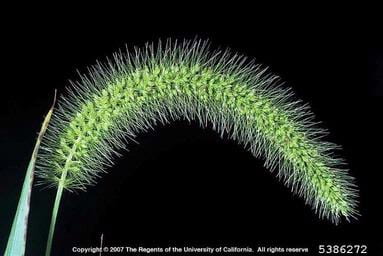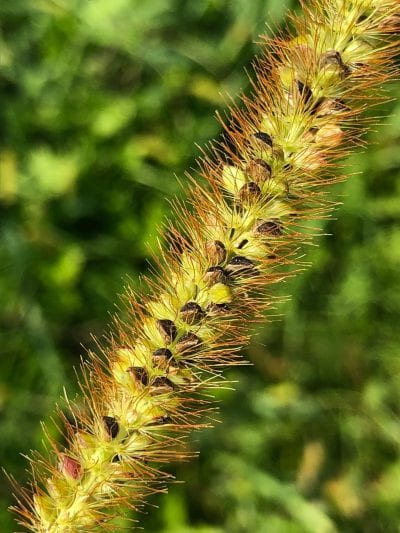There are three problematic species of foxtails (Setaria) in the state of New York. These species are yellow (S. glauca), green (S. viridis), and giant (S. faberi) foxtail. All can be problems in small fruit (berries), vegetables, and field crops (especially in late sweet corn as a harvest impediment). All three are summer annual grasses that are widespread in the US and in New York, and are nonnative to the US (yellow foxtail is native to Eurasia, green foxtail to China, and giant foxtail to East Asia).
All three foxtails have a seed head that resembles a fox’s tail (hence the common name), and have a fibrous root system. They all grow upright and have a fringed ligule (a hairy fringe where the leaf blade joins with the stem). They can be differentiated by the size and color of their seedheads and the location and types of hairs on their leaves.
All three are troublesome weeds in row crops, but giant foxtail can cause higher yield losses than the other two species. At high density, however, all three can reduce yields in corn and soy.
Danger to livestock
The bristles of yellow and giant foxtails can become lodged in the gums and tongues of livestock. This can develop into serious ulcerations in grazing animals.
Similar species
Table 5: Compares yellow, green, and giant foxtails (Setaria glauca, S. viridis, and S. faberi respectively) and fall panicum (Panicum dichtomiflorum).
| Species | Yellow foxtail (Setaria glauca) | Green foxtail (Setaria viridis) | Giant foxtail (Setaria faberi) | Fall panicum (Panicum dichtomiflorum) | ||
|---|---|---|---|---|---|---|
| Similarities | Basic characteristics: have a fringed ligule, upright habit, fibrous root system, and foxtail-shaped flower head. | See basic characteristics description. | See basic characteristics description. | Only at seedling stage does fall panicum resemble foxtail spp. | ||
| Differences | On the base of the leaf blade there are long wispy hairs on the upper surface; margins are smooth or somewhat rough | Blades are rough that lacks hair; sheath is hairy at the margins | Largest of the species, especially the nodding seedhead; many short hairs on upper surface of blades and the margins of the sheath on seedlings and mature plants | Fall panicum is hairy on both the blade and sheath, while yellow foxtail is hairy on the upper leaf blade. The other two are largely hairless. Also, yellow foxtail’s wispy hairs at the collar region are diagnostic for that species. |
Green foxtail
Scientific name: Setaria viridis
Identification
Seedlings: The leaf bud is rolled.
Seed leaf shape: oval
Seed leaf size: 0.5-1 inch (1.3-2.5 cm) long nu 0.1-0.2 inches (0.3-0.5 cm) wide
Mature plant: The sheath is flattened and gives the appearance that the leaf bud folded rather than rolled; however, if the stem is examined it will show that it is indeed rolled. The margins are hairy.
Height: 0.5-3 ft (15-91 cm)
Leaf blade size: 10-12 inches (25-30 cm) long by 0.25-0.38 inches (0.5- 1 cm) wide
Flowers/fruit: The seedhead is an upright, cylindrical, bristly panicle. The spikelets are green, hence the common name.
Panicle size: 1.25-3.25 inches (3-8 cm) long by 0.5-1 inches (1.3-2.5 cm) wide
Spikelet size: 0.06-0.08 inches (0.15-0.2 cm)
Bristle size: 0.25-0.5 inches (0.6-1.3 cm)
Seed size: 0.09 inches (0.23 cm) long by 0.05 inches (0.12 cm) wide
Giant foxtail
Scientific name: Setaria faberi
Other names: Chinese foxtail
Identification
Seedlings: The leaf bud is rolled.
Giant foxtail fringe of hairs ligule.
Photo by John D. Bryd of Mississippi State University, via Bugwood.org
Mature plant: The sheath is smooth and hairy at the margins.
Max height: 6.5 ft (2 m)
Average height: 2.5-4 ft (0.8-1.2 m) tall
Leaf blade: 12-20 inches (30-51 cm) long by 0.3-0.8 inches (0.8-2 cm) wide
Flowers/fruit: The seedhead is a cylindrical, bristly panicle. It is distinctive from the Yellow (S. glauca) and Green (S. viridis) species of foxtails as the seed head droops when mature.
Panicle size: 1.5-8 inches (4-20 cm) long by a max of 1.25 inches (3.2 cm)
Spikelet size: 0.13 inches (0.3 cm) long
Bristle length: 0.2-0.4inches (0.5-1 cm)
Seed size: 0.1 inches (0.3 cm) long by 0.06 inches (0.15 cm) wide
Giant foxtail inflorescence.
Photo by Joseph M. DiTomaso of University of California–Davis, via Bugwood.org
Yellow foxtail
Scientific names: Setaria glauca, previously S. lutescens
Other names: summer-grass, golden foxtail, wild millet
Identification
Seedlings: the leaf bud is rolled.
Seed leaf shape: Elongated
Seed leaf size: Up to 2 inches (5 cm) long by 0.13 inches (0.3 cm) wide
Mature plant: The sheath is flattened and gives the appearance that the leaf bud folded rather than rolled; however, if the stem is examined it will show that it is indeed rolled. The shealth is hairless.
Height: 2-4 ft (0.6-1.2 m)
Blades: 10-12 inches (25-30 cm) long by 0.25-0.5 inches (0.6-1.3 cm) wide
Flowers/fruit: Seedhead is a cylindrical bristly, upright panicle. The bristles turn yellow when mature, hence its common name.
Panicle size: 0.75-6 inches (2-15 cm) long by 0.5 inches (1.3 cm) wide
Spikelet size: 0.08-0.1 inches (0.2-0.25 cm)
Bristle size: 0.16-0.35 inches (0.4-0.8 cm)
Seed size: 0.13 inches (0.3 cm) long by 0.8 inches (0.2 cm) wide
Similar species
Table 5: Compares yellow, green, and giant foxtails (Setaria glauca, S. viridis, and S. faberi respectively) and fall panicum (Panicum dichtomiflorum).
| Species | Yellow foxtail (Setaria glauca) | Green foxtail (Setaria viridis) | Giant foxtail (Setaria faberi) | Fall panicum (Panicum dichtomiflorum) | ||
|---|---|---|---|---|---|---|
| Similarities | Basic characteristics: have a fringed ligule, upright habit, fibrous root system, and foxtail-shaped flower head. | See basic characteristics description. | See basic characteristics description. | Only at seedling stage does fall panicum resemble foxtail spp. | ||
| Differences | On the base of the leaf blade there are long wispy hairs on the upper surface; margins are smooth or somewhat rough | Blades are rough that lacks hair; sheath is hairy at the margins | Largest of the species, especially the nodding seedhead; many short hairs on upper surface of blades and the margins of the sheath on seedlings and mature plants | Fall panicum is hairy on both the blade and sheath, while yellow foxtail is hairy on the upper leaf blade. The other two are largely hairless. Also, yellow foxtail’s wispy hairs at the collar region are diagnostic for that species. |
Management for foxtail species
Chemical
Information on yellow, green, and giant foxtails chemical control methods can be found on Cornell’s Turfgrass and Landscape Weed ID.
Chemical management strategies for green foxtail.
Chemical management strategies for giant foxtail.
Chemical management strategies for yellow foxtail.
You can also use CCE Eastern NY Horticulture’s herbicide lookup tool to find the efficacy of various herbicides on foxtails. For general guidance on weed control, get the latest edition of the Cornell Crop and Pest Management Guidelines.
Non-chemical
Foxtails in general are affected by crop competition and shady conditions. Tillage timing and depth are essential in controlling foxtail species. Generally, the seeds are a decent size (especially yellow foxtail); if they are left on the surface this encourages predation by birds, rodents, and insects. Foxtail grass seed is viable in the soil for more than two years, but most seeds will expire if buried and will not appear even if they are at the correct emergence depth. Since seeds undergo a secondary dormancy in hot weather during the summer, fallowing is futile. Foxtails easily re-root when the soil is wet. Giant foxtails do well in no-till systems due to its ability to germinate at the surface, especially if crop residue is present to contribute a moist microenvironment.
Organic mulch does not provide control for yellow and green foxtails since they are able to grow through to the surface. They also can grow when shaded as they rely on food stores in their seed. Adding mulch can be beneficial in order to delay and reduce growth, which can provide crops the time to have the upper hand. Cleaning up the field after harvest can help prevent seed spread.
Herbicide resistance in foxtails
Reported as of 2021:
Green foxtail
North America
U.S.
Group 1 (1 state)
Group 2 (1 state)
Group 3 (1 state)
Canada
Group 2 (Ontario)
Groups 1 and 3 (Manitoba, Alberta, and Saskatchewan)
Other continents
Europe
Groups 2 and 5
Giant foxtail
North America
U.S.
Group 1 (3 states)
Group 2 (5 states)
Group 5 (2 states)
Canada
Group 2 (Ontario)
Other continents
Europe
Group 5 (Spain)
Yellow foxtail
North America
U.S.
Group 2 (1 state)
Group 5 (1 state)
Canada
Group 5 (Ontario)
Other continents
Europe
Group 5 (France and Spain)
For a more detailed report, please visit the reference section below or visit the International Herbicide-Resistant Weed Database homepage for more information: http://www.weedscience.org/Home.aspx
Resources
For another source on identification consider Illinois Wildflowers page on giant foxtail.
For more identification resources check out the University of Missouri’s Weed ID Guide on giant foxtail.
As another source of biology and management of giant foxtail, look at Michigan State University.
For biological and distribution information, check the Invasive Plant Atlas giant foxtail page.
The New York Flora Atlas also has information on NYS specific distribution of giant foxtail as well as its other common names.
For Weed ID infö for green foxtail look at the University of Missouri’s Weed ID Guide.
Another extension resource is Iowa State University with their green foxtail page.
NC State Extension has information on green foxtail management.
Washington State University has a profile on yellow foxtail, which focuses on it’s harmful properties to animal agriculture.
Missouri State also has a Weed ID Guide on yellow foxtail.
Penn State has a yellow foxtail page that has basic ID characteristics and specifics on chemical management.
Cornell University’s Turfgrass and Landscape Weed ID app. Identification and control options for weeds common to turf, agriculture, and gardens in New York; uses a very simple decision tree to identify your weed. Available for all three foxtail species.
University of Missouri IPM Weed of the Month publication for identifying foxtails.
Uva R H, Neal J C, DiTomaso J M. 1997. Weeds of the Northeast. Book published by Cornell University, Ithaca NY. The go-to for weed ID in the Northeast; look for a new edition sometime in 2019.
Matzrafi, M. (2018) ‘Climate change exacerbates pest damage through reduced pesticide efficacy’, Pest Management Science, 75(1), pp. 9–13. doi:10.1002/ps.5121.
Varanasi, A., Prasad, P.V.V. and Jugulam, M. (2016) ‘Impact of climate change factors on weeds and herbicide efficacy’, Advances in Agronomy, pp. 107–146. doi:10.1016/bs.agron.2015.09.002.
Daniel W. Staniforth. Competitive effects of three foxtail species on soybeans. Published online by Cambridge University Press 12 June 2017.
Herbicide resistance details (2021)
Yellow foxtail
North America
U.S.
Mid-west: Minnesota, group 2 (imazethapyr)
Mid-Atlantic: Maryland, group 5 (atrazine, cyanazine, and simazine)
Canada
In the province of Ontario, group 5 (atrazine)
Other continents
Europe
France and Spain, group 5 (atrazine)
Green foxtail
North America
U.S.
Mid-West: Wisconsin, group 2 (imazamox); North Dakota, group 3 (trifluralin)
North West: Montana, group 1 (diclofop-methyl, fenoxaprop-ethyl, fluazifop-butyl, pinoxaden, and sethoxydim)
Canada
Province of Ontario, group 2 (flucarbazone-Na, imazethapyr, nicosulfuron, and pyrithiobac-sodium)
Province of Manitoba, groups 1 (diclofop-methyl, fenoxaprop-ethyl, sethoxydim, and tralkoxydim), 2 (imazethapyr, and sulfosulfuron), 3 (ethalfluralin, and trifluralin);
Province of Alberta, groups 1 (diclofop-methyl, fenoxaprop-ethyl, and sethoxydim) and 3 (ethalfluralin and trifluralin)
Province of Saskatchewan, groups 1 (fenoxaprop-ethyl, and sethoxydim) and 3 (ethalfluralin, and trifluralin)
Other continents
Europe
France, groups 2 (foramsulfuron, and nicosulfuron) and 5 (atrazine); Spain, group 5 (atrazine)
Giant foxtail
North America
U.S.
Mid-Atlantic: Maryland, group 5 (atrazine)
Mid-West: Minnesota, group 2; Iowa, groups 1 (clethodim, fenoxaprop-ethyl, fluazifop-butyl, quizalofop-ethyl, and sethoxydim) and 5 (atrazine); Wisconsin, groups 1 (fluazifop-butyl, and sethoxydim) and 2 (imazethapyr, and nicosulfuron); Illinois, groups 1 (clethodim, and fluazifop-butyl) and 2 (imazethapyr, and nicosulfuron); Indiana, group 2 (nicosulfuron, and rimsulfuron); Michigan, group 2 (foramsulfuron, imazethapyr, and nicosulfuron)
Canada
Province of Ontario: group 2 (imazethapyr)
Other continents
Europe
Spain, group 5 (atrazine)
Please visit International Herbicide-Resistant Weed Database for more information on herbicide resistance.


















